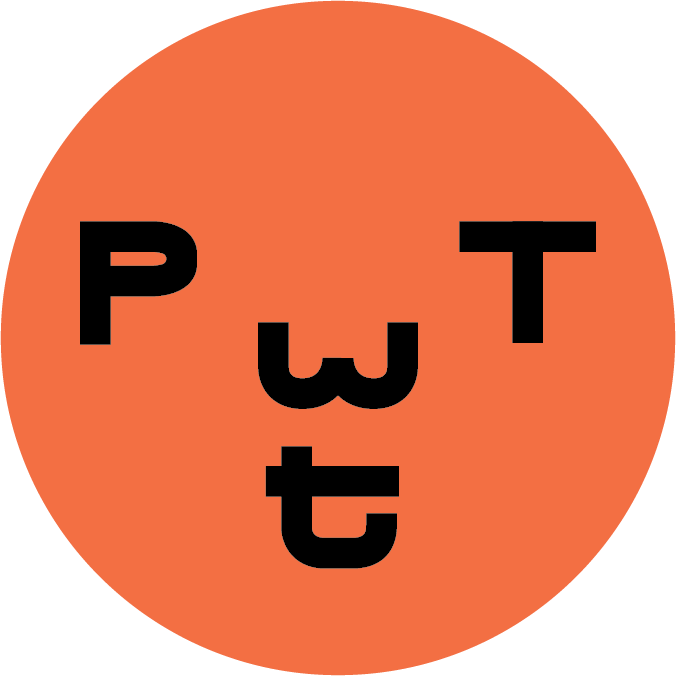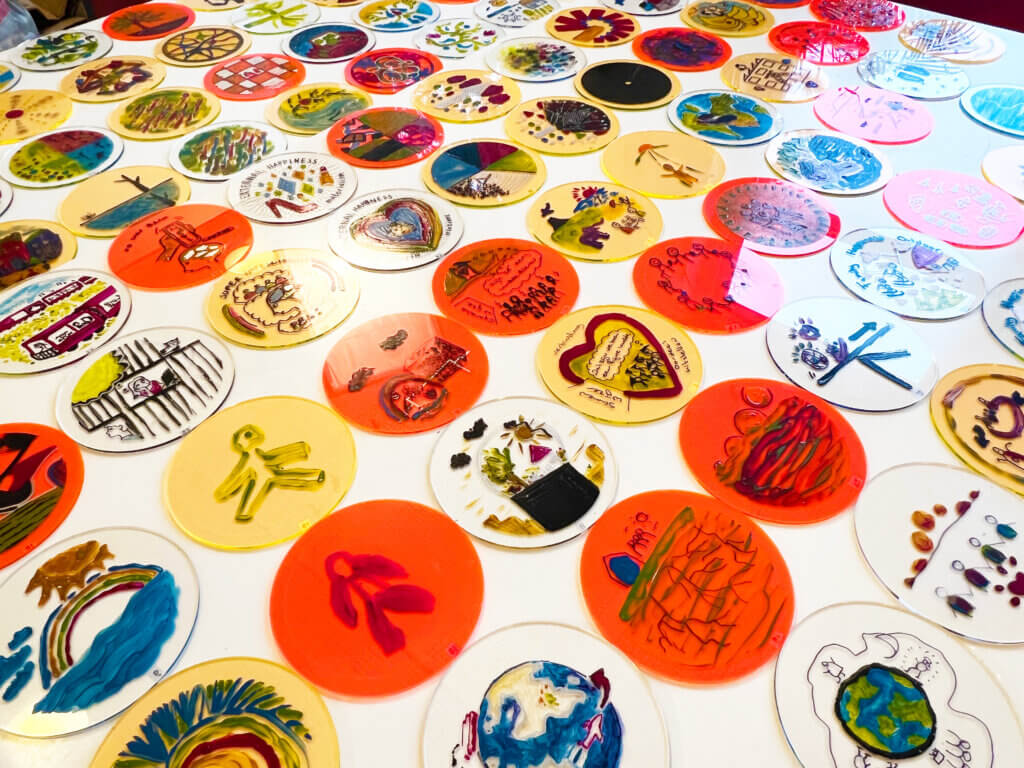
Sunsets & Sunrises
Which futures are we letting go of—and which new ones are emerging?
A 1.5–4 hour activity for 1–20 people
Is this the activity for your group?
- 1.5–4 hour duration
- Number of people: 1–20 — the real limit is the amount of materials needed
- A sensitive facilitator is needed. They can also participate in the activity.
- High setup
- Medium difficulty
- Medium imaginative load
- High trust required
Why play this?
- Embracing Ambiguity (engaging with emotions around uncertainty and transitions)
- Staying With The Trouble (recognising the complexities, challenges, and emotions of transitions)
- Collective Imagining (exploring different past and present imaginaries of futures together)
Header image: example of sunsets and sunrises created by workshop participants, each disc representing either a ‘lost’ or ‘emerging’ future.
Notes for the organiser/facilitator
Sunsets & Sunrises is still in development, and as a relatively complex activity, the instructions here are somewhat provisional. We also do not analyse any of the discs that participants produced, in these instructions. If you would like to run Sunsets & Sunrises yourself, we recommend getting in touch: Dan Lockton d.lockton@norwichuni.ac.uk and Femke Coops encoops@outlook.com and we can help advise on how you can tailor it to your context.
This is (potentially) a quite emotional activity for participants, since they are invited to reflect on dreams which they may have given up on, as well as hopes and fears. It is important that the facilitator(s) are sensitive to this, and ensure that participants feel comfortable with the degree of sharing that they do. Whether or not to have a plenary moment where all participants share their discs (with an explanation) is dependent on the comfort and level of trust in the room;
It is a long activity, to give participants time to think, reflect, and share with each other, as well as the actual planning and drawing or painting of the sunset and sunrise discs. If it needs to be shorter, concentrating only on the sunset (or sunrise) half of the activity can be done, but is potentially less satisfying / personally transformative for participants.
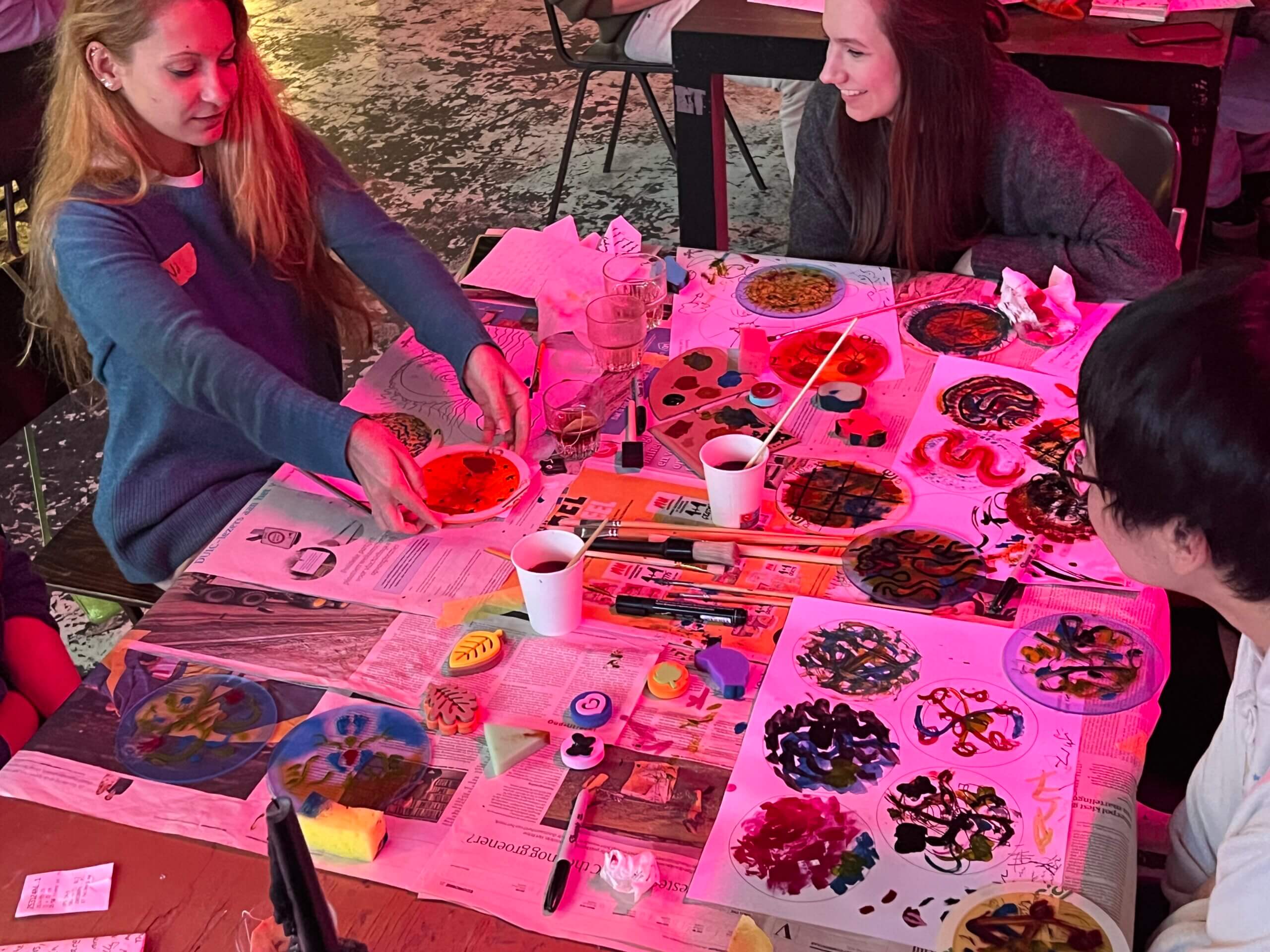
Components
Sunsets & Sunrises involves preparation of materials: the acrylic discs, templates, paint/brushes and/or marker pens. The transparent aspect enables illumination of the discs, or putting them in front of a window, to give more of a sunset/sunrise effect as part of an exhibition after the workshop. Tracing paper cut into circles could be an alternative.
- Acrylic (plexiglas / Perspex) discs in translucent orange and yellow, and fully clear shades, 150mm diameter. In the full version with both sunsets and sunrises, each participant should have 2 discs (free choice of colours—although you may wish to be more specific. Tracing paper cut into circles could be an alternative.
- Template sheet — five circles of the same diameter as the discs, on A3 paper, to enable participants to work out ideas / practise their visualisations. Download the file here
- Acrylic paint in a limited palette of colours
- Paintbrushes of different sizes, sponges, and/or foam shape stamps
- Permanent marker pens—e.g. Sharpies—in at least black, ideally also silver/white or a metallic colour. If not using paints, then a range of colours of marker pens perhaps including ‘paint’ ones is needed.
- Newspaper or other coverings for tables (if using paint)
- Jam jars or other glasses of water for paintbrushes
- Palettes (or just pieces of cardboard) for blobs of paint
- Optional: Clothes pegs and a washing line (or just string) for displaying the finished discs
Acrylic discs can be ordered from craft/modelling material suppliers, such as (in NL) https://kunststofplatenshop.nl/
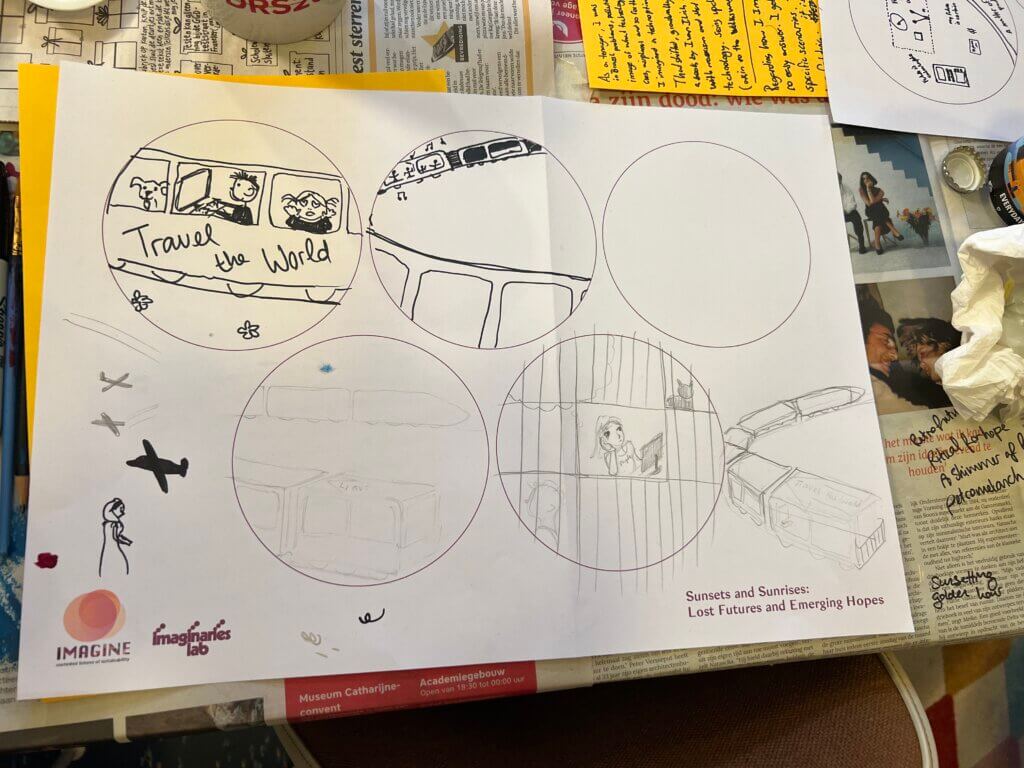
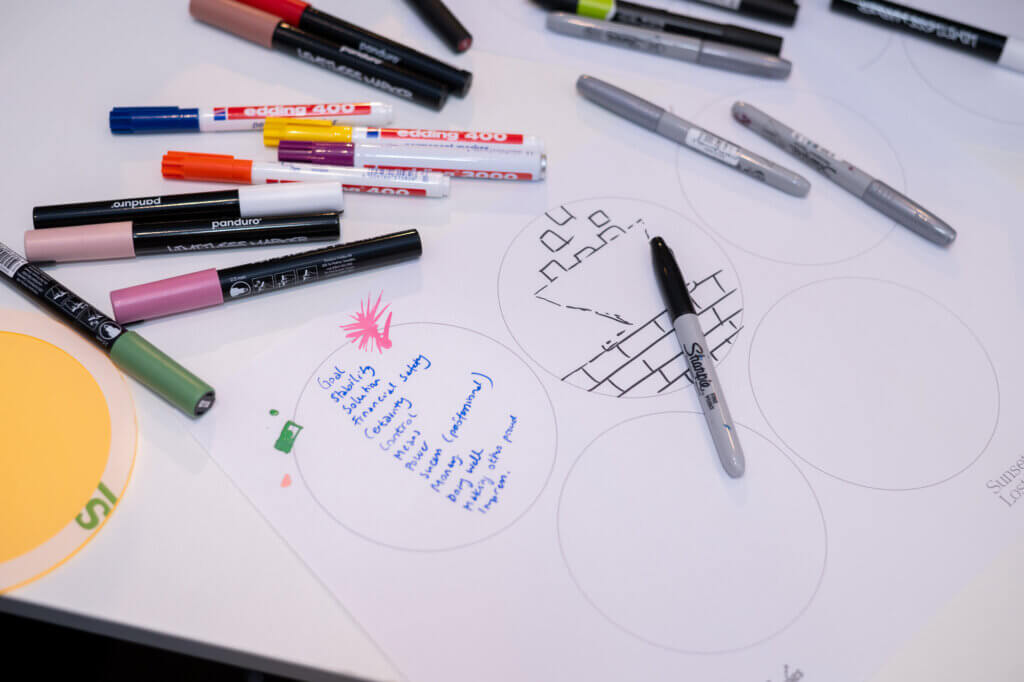
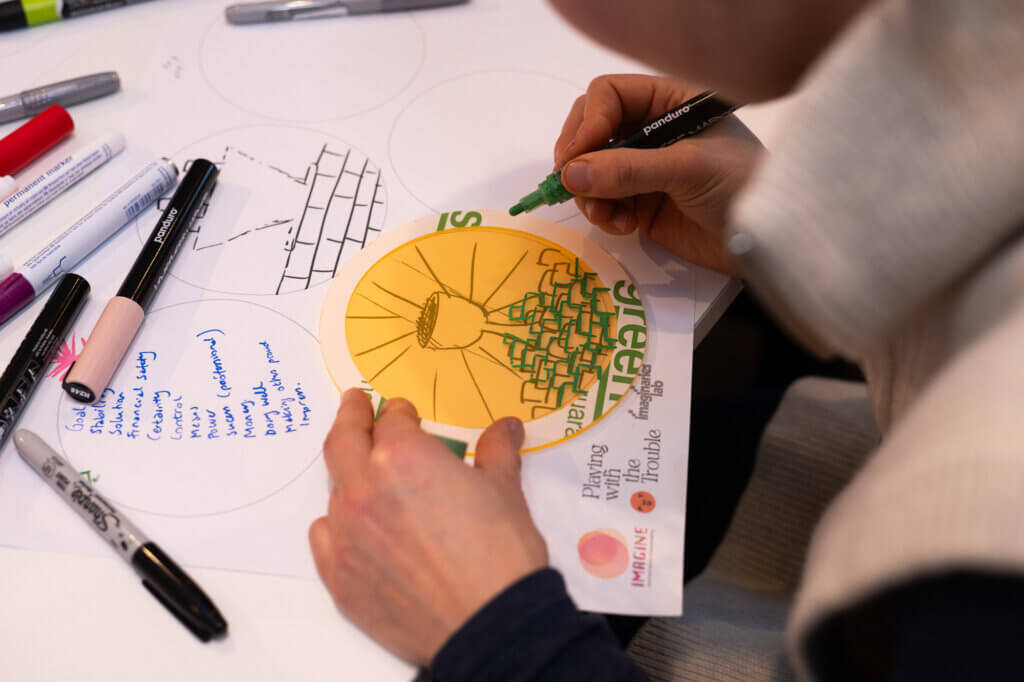
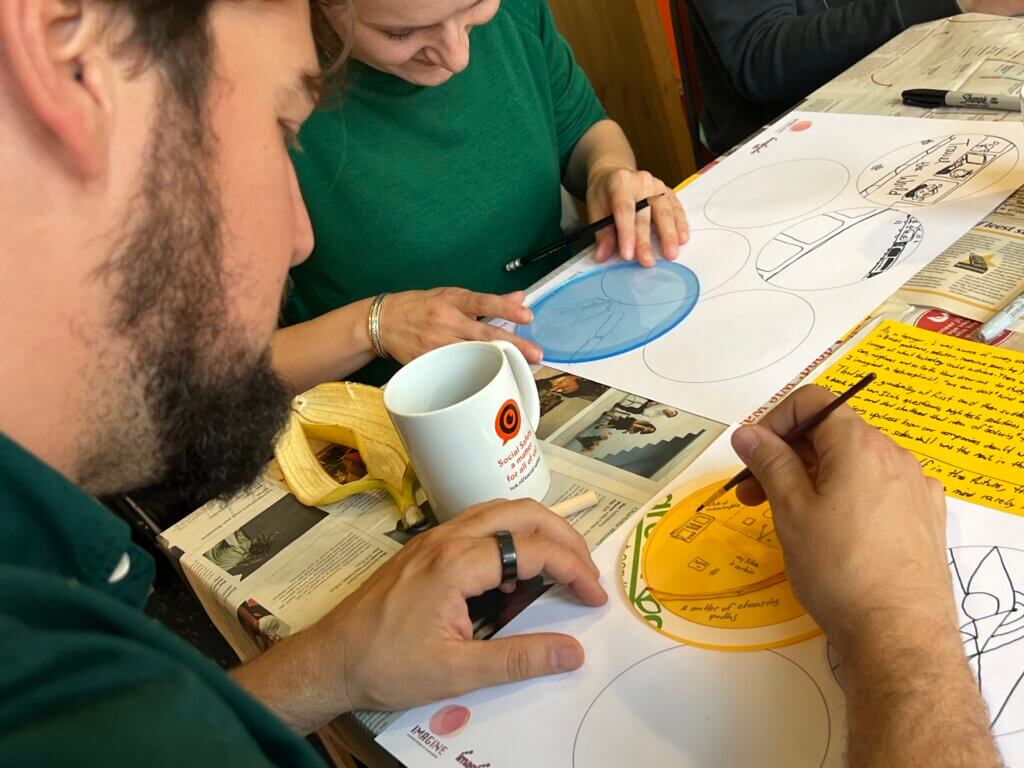
The template, together with either pens or paint, can be used for participants to sketch and work out ideas, and then traced with the discs. Photo credit for photos 2 and 3: Alexander Mertsch.
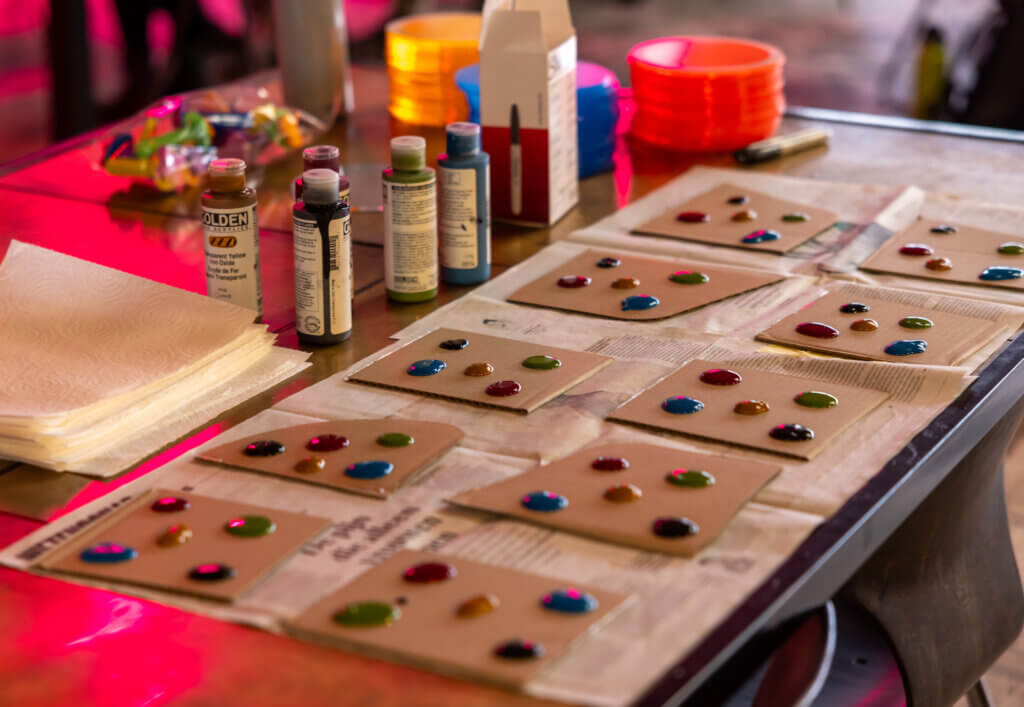
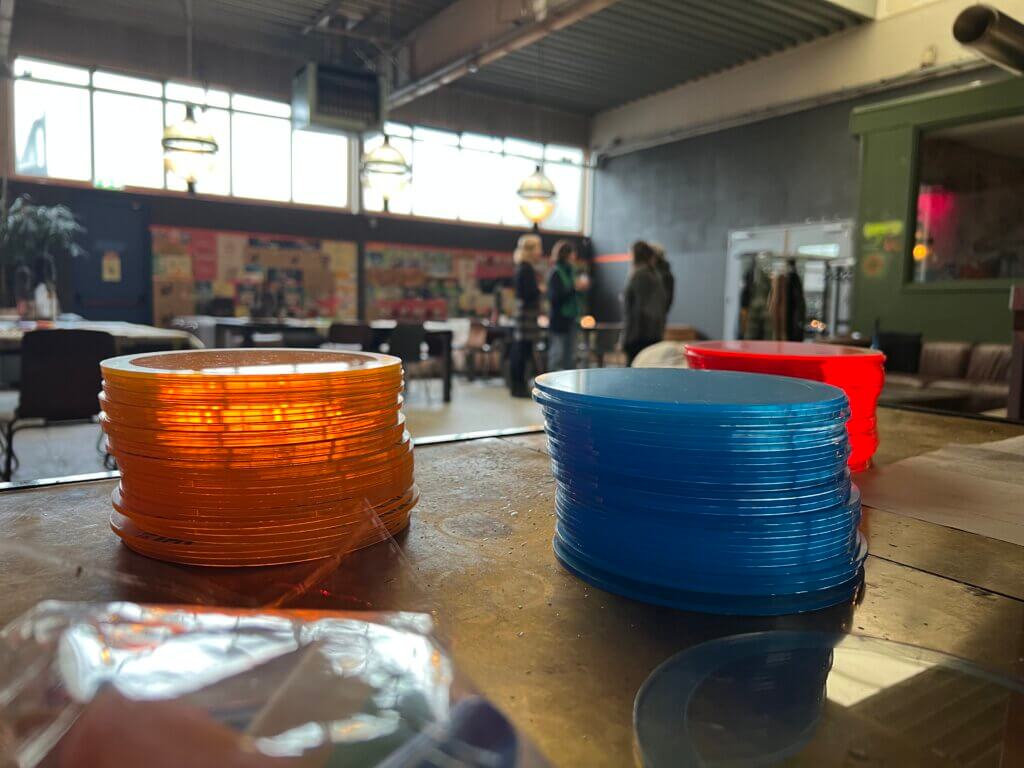
Paint palettes made from pieces of cardboard with five blobs of acrylic paint on them (photo by Paula Angelica); and the yellow, orange, and clear discs stacked before a workshop.
Background and objectives
“There is nothing new under the sun, but there are new suns.”
Octavia Butler [1]
What is going away, in our transitions to (more sustainable?) futures? And how does that feel? Sunsets and Sunrises (developed by Femke Coops and Dan Lockton) aims to give us space to engage with our emotions around imagined futures that are disappearing (and appearing), as part of the phase-out and breakdown of systems, structures and practices. Sunsets and Sunrises uses creative materials to prompt participants to share ideas and emotions of imagined futures that we have perhaps had to let go (sunsets) of, or which we realise are disappearing, both personally and at a larger scale—whether as part of transitions to a more sustainable society or exactly because of the current state of the world. It can create space for grieving or even a ritual for saying goodbye to ideas. But it also explores (sunrises) what futures might be on their way, already effective (and affective) in our presents, bringing hope for better worlds and ways to live. It is both a collaborative art method and a participatory research probe into imaginaries of futures. In an ‘unusual collaborations’ context, the activity might be reframed to focus on imagined futures relating to projects or professional (inter-)disciplinary development—how are our visions changing? And what can we learn about each other’s visions?
Sunsets and Sunrises was developed as part of the IMAGINE project and adapted for the Playing with the Trouble context. Through workshops with participants in the Netherlands and Norway, we have built on Femke Coops’s work on designing spaces for letting go in sustainability transitions, also taking inspiration from work including Mark Fisher’s writing on nostalgia for lost futures, Candy Chang’s After the End, and Vanessa Andreotti’s Hospicing Modernity.
Collectively, sharing our lost futures (via our sunsets) creates a collaborative memorial, but also (via our sunrises) a shared witnessing of the emergence of hope for new possibilities.
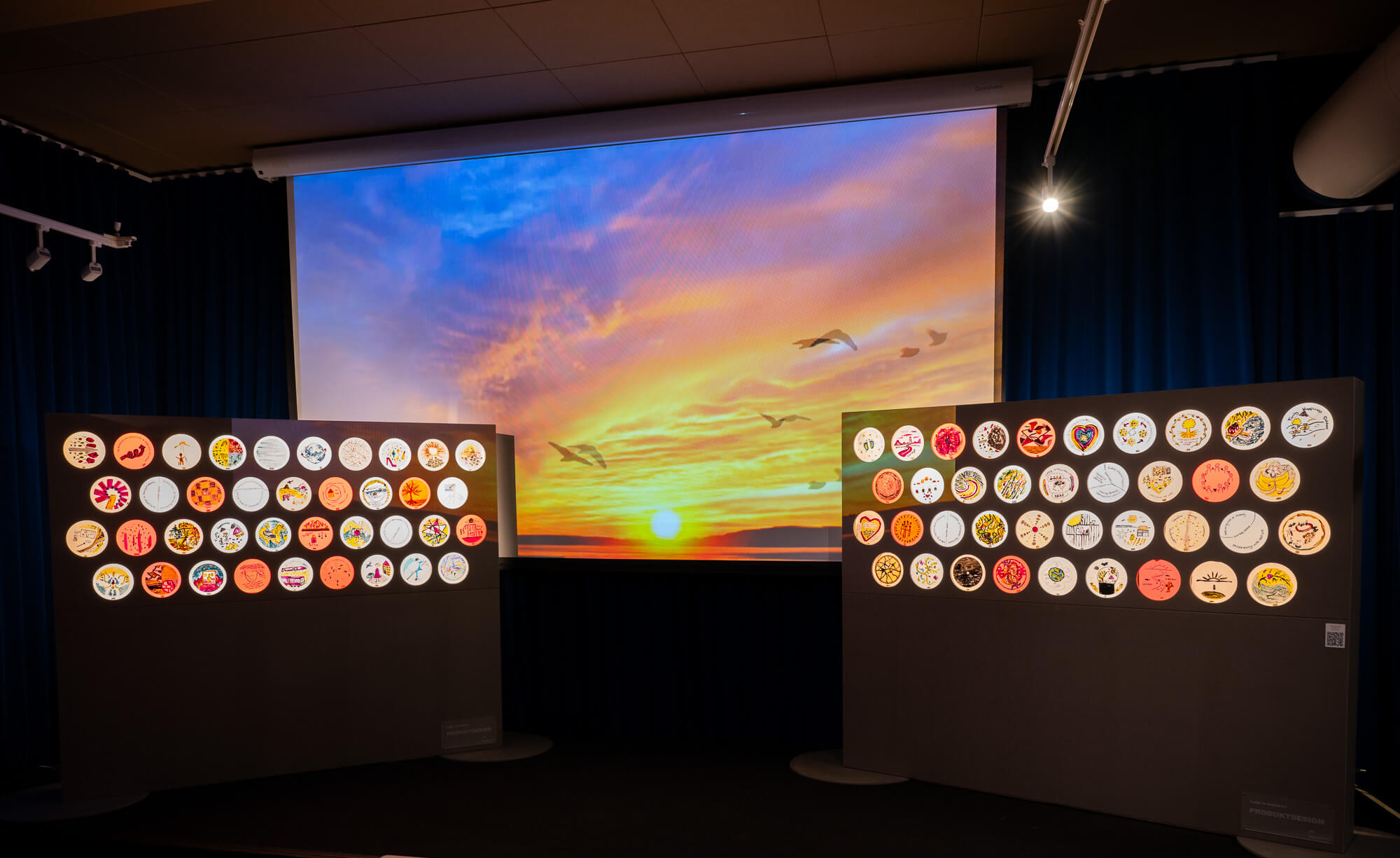
Example
The example we describe here combines features from multiple Sunsets & Sunrises workshops. Including breaks, this workshop structure can take 3–4 hours. Images here include photos by Paula Angelica and Alexander Mertsch.
A table set up for 8 participants. Usually we would recommend a smaller group (3–5 people per table). The pink cards are part of the icebreaker exercise. | Setup & introduction (20 mins) Groups of 3–5 participants each sit at newspaper-covered tables, with some pens, blank paper, and the template sheets. A separate central table has paint, more pens, paintbrushes and foam shapes of various kinds, and the acrylic discs. An icebreaker or bonding exercise helps participants get to know the others at their tables, ideally with more values-based or deeper existential questions which stimulate conversation with each other beyond people’s occupations and reasons for participation. See Falling in Love: A Warm-Up. |
Here participants have written down their lost and emerging futures on the yellow sheets (on the left, two participants have started drawing on the templates). | Preparation (30 mins) To prompt participants to think about their lost futures and emerging hopes, we used a form of guided meditation to get them in touch with their lived experiences and personal (emotional) landscapes. Once they felt able to, we asked the participants to write down or visualise this ‘lost’ future image, so they could use it as inspiration for their sunset. Then we explored what possible futures could emerge as their imagined future was disappearing or had already disappeared. Similarly, they noted this down or visualised it as a starting point for their sunrise. |
| Visualising Sunsets & Sunrises (60 minutes) Each table was given paints, brushes, foam shapes, and pens. Using the template, participants explored how to visualise their sunset and sunrise, and then chose a disc for each from the central table, and started painting or drawing. Practice sketches on the template can be traced. Conversations during the creation of the discs were encouraged but not obligatory, in order to create space for the personal preferences of participants. Some groups created in silence, where others were actively discussing their future imaginaries and helping each other in visualising them. A full hour is a long time, but allows for a more relaxed and exploratory process. For many participants, using paintbrushes or drawing is not a regular activity, so some re-familiarisation exploration is enjoyable. | |
| Collective sensemaking and exhibition (30 mins) Moving from the individual to the collective, participants shared their sunsets and sunrises in their groups, reflecting on their creations and exploring relations between the different discs. This can be done in the small groups, or if there is a higher level of trust / depending on how many participants there are, with the whole room. Depending on participants’ preferences, the finished sunsets and sunrises can be exhibited/displayed here (e.g. using clothes pegs, or placed on a desk) while the paint is drying. When the paint is dry, the ‘border’ can be peeled off the discs. | |
| Plenary reflection (15 mins) To create a space for feedback and reflection, we closed the workshop with a plenary reflection. Participants were asked to share their experiences and reflect on the method, materials and interactions. |
[1] Canavan, G. (2014). “There’s Nothing New / Under The Sun, / But There Are New Suns”: Recovering Octavia E. Butler’s Lost Parables. Los Angeles Review of Books, June 9, 2014. https://lareviewofbooks.org/article/theres-nothing- new-sun-new-suns-recovering-octavia-e-butlers- lost-parables/
